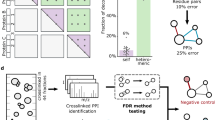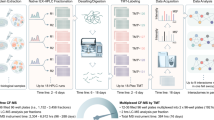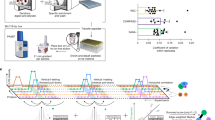Abstract
Biological systems are controlled by protein complexes that associate into dynamic protein interaction networks. We describe a strategy that analyzes protein complexes through the integration of label-free, quantitative mass spectrometry and computational analysis. By evaluating peptide intensity profiles throughout the sequential dilution of samples, the MasterMap system identifies specific interaction partners, detects changes in the composition of protein complexes and reveals variations in the phosphorylation states of components of protein complexes. We use the complexes containing the human forkhead transcription factor FoxO3A to demonstrate the validity and performance of this technology. Our analysis identifies previously known and unknown interactions of FoxO3A with 14-3-3 proteins, in addition to identifying FoxO3A phosphorylation sites and detecting reduced 14-3-3 binding following inhibition of phosphoinositide-3 kinase. By improving specificity and sensitivity of interaction networks, assessing post-translational modifications and providing dynamic interaction profiles, the MasterMap system addresses several limitations of current approaches for protein complexes.
This is a preview of subscription content, access via your institution
Access options
Subscribe to this journal
Receive 12 print issues and online access
$209.00 per year
only $17.42 per issue
Buy this article
- Purchase on Springer Link
- Instant access to full article PDF
Prices may be subject to local taxes which are calculated during checkout




Similar content being viewed by others
References
Ito T, Tashiro K, Kuhara T Systematic analysis of Saccharomyces cerevisiae genome: gene network and protein-protein interaction network. Tanpakushitsu Kakusan Koso 46 2407–2413 2001
Uetz P, Hughes RE Systematic and large-scale two-hybrid screens. Curr. Opin. Microbiol. 3 303–308 2000
Gavin AC et al. Functional organization of the yeast proteome by systematic analysis of protein complexes. Nature 415 141–147 2002
Gavin AC et al. Proteome survey reveals modularity of the yeast cell machinery. Nature 440 631–636 2006
Ho Y et al. Systematic identification of protein complexes in Saccharomyces cerevisiae by mass spectrometry. Nature 415 180–183 2002
Krogan NJ et al. Global landscape of protein complexes in the yeast Saccharomyces cerevisiae. Nature 440 637–643 2006
Butland G et al. Interaction network containing conserved and essential protein complexes in Escherichia coli. Nature 433 531–537 2005
Figeys D Functional proteomics: mapping protein-protein interactions and pathways. Curr. Opin. Mol. Ther. 4 210–215 2002
Verma R et al. Proteasomal proteomics: identification of nucleotide-sensitive proteasome-interacting proteins by mass spectrometric analysis of affinity-purified proteasomes. Mol. Biol. Cell 11 3425–3439 2000
Gygi SP et al. Quantitative analysis of complex protein mixtures using isotope-coded affinity tags. Nat. Biotechnol. 17 994–999 1999
Ross PL et al. Multiplexed protein quantitation in Saccharomyces cerevisiae using amine-reactive isobaric tagging reagents. Mol. Cell. Proteomics 3 1154–1169 2004
Schmidt A, Kellermann J, Lottspeich F A novel strategy for quantitative proteomics using isotope-coded protein labels. Proteomics 5 4–15 2005
Ong SE et al. Stable isotope labeling by amino acids in cell culture, SILAC, as a simple and accurate approach to expression proteomics. Mol. Cell. Proteomics 1 376–386 2002
Oda Y, Huang K, Cross FR, Cowburn D, Chait BT Accurate quantitation of protein expression and site-specific phosphorylation. Proc. Natl. Acad. Sci. USA 96 6591–6596 1999
Ranish JA et al. The study of macromolecular complexes by quantitative proteomics. Nat. Genet. 33 349–355 2003
Himeda CL et al. Quantitative proteomic identification of six4 as the trex-binding factor in the muscle creatine kinase enhancer. Mol. Cell. Biol. 24 2132–2143 2004
Blagoev B et al. A proteomics strategy to elucidate functional protein-protein interactions applied to EGF signaling. Nat. Biotechnol. 21 315–318 2003
Brand M et al. Dynamic changes in transcription factor complexes during erythroid differentiation revealed by quantitative proteomics. Nat. Struct. Mol. Biol. 11 73–80 2004
Li XJ, Yi EC, Kemp CJ, Zhang H, Aebersold R A software suite for the generation and comparison of peptide arrays from sets of data collected by liquid chromatography-mass spectrometry. Mol. Cell. Proteomics 4 1328–1340 2005
Silva JC, Gorenstein MV, Li GZ, Vissers JP, Geromanos SJ Absolute quantification of proteins by LCMS: a virtue of parallel MS acquisition. Mol. Cell. Proteomics 5 144–156 2006
Callister SJ et al. Normalization approaches for removing systematic biases associated with mass spectrometry and label-free proteomics. J. Proteome Res. 5 277–286 2006
Andersen JS et al. Proteomic characterization of the human centrosome by protein correlation profiling. Nature 426 570–574 2003
Brunet A et al. Stress-dependent regulation of FOXO transcription factors by the SIRT1 deacetylase. Science 303 2011–2015 2004
Keller A, Nesvizhskii AI, Kolker E, Aebersold R Empirical statistical model to estimate the accuracy of peptide identifications made by MS/MS and database search. Anal. Chem. 74 5383–5392 2002
Van Der Heide LP, Hoekman MF, Smidt MP The ins and outs of FoxO shuttling: mechanisms of FoxO translocation and transcriptional regulation. Biochem. J. 380 297–309 2004
Brunet A et al. Akt promotes cell survival by phosphorylating and inhibiting a Forkhead transcription factor. Cell 96 857–868 1999
Brunet A et al. 14–3-3 transits to the nucleus and participates in dynamic nucleocytoplasmic transport. J. Cell Biol. 156 817–828 2002
Nesvizhskii AI, Keller A, Kolker E, Aebersold R A statistical model for identifying proteins by tandem mass spectrometry. Anal. Chem. 75 4646–4658 2003
Nesvizhskii AI, Aebersold R Interpretation of shotgun proteomic data: the protein inference problem. Mol. Cell. Proteomics 4 1419–1440 2005
Perkins DN, Pappin DJ, Creasy DM, Cottrell JS Probability-based protein identification by searching sequence databases using mass spectrometry data. Electrophoresis 20 3551–3567 1999
Kops GJ et al. Direct control of the Forkhead transcription factor AFX by protein kinase B. Nature 398 630–634 1999
Liu H, Sadygov RG, Yates JR III A model for random sampling and estimation of relative protein abundance in shotgun proteomics. Anal. Chem. 76 4193–4201 2004
Gavin IM, Kukhtin A, Glesne D, Schabacker D, Chandler DP Analysis of protein interaction and function with a 3-dimensional MALDI-MS protein array. Biotechniques 39 99–107 2005
Guerrero C, Tagwerker C, Kaiser P, Huang L An integrated mass spectrometry-based proteomic approach: quantitative analysis of tandem affinity-purified in vivo cross-linked protein complexes (QTAX) to decipher the 26S proteasome-interacting network. Mol. Cell. Proteomics 5 366–378 2006
Smith RD et al. An accurate mass tag strategy for quantitative and high-throughput proteome measurements. Proteomics 2 513–523 2002
Chen SS, Aebersold R LC-MS solvent composition monitoring and chromatography alignment using mobile phase tracer molecules. J. Chromatogr. B Analyt. Technol. Biomed. Life Sci. 829 107–114 2005
Duda RO, Hart PE, Stork DG Pattern Classification vol. 1, edn. 2, (Wiley-Interscience, New York, 2000)
Nesvizhskii AI, Aebersold R Analysis, statistical validation and dissemination of large-scale proteomics data sets generated by tandem MS. Drug Discov. Today 9 173–181 2004
Hastie T, Tibshirani R, Friedman J The Elements of Statistical Learning (Springer, New York, 2001)
Colinge J, Masselot A, Carbonell P, Appel RD InSilicoSpectro: an open-source proteomics library. J. Proteome Res. 5 619–624 2006
Keller A, Eng J, Zhang N, Li XJ, Aebersold R A uniform proteomics MS/MS analysis platform utilizing open XML file formats. Mol. Syst. Biol. 1 2005, 0017 2005
Shannon P et al. Cytoscape: a software environment for integrated models of biomolecular interaction networks. Genome Res. 13 2498–2504 2003
Acknowledgements
The authors thank Luis Mendoza for helpful discussions. Alexander Schmidt for help with the FT-ICR spectrometer. We thank M. Greenberg for the gift of pcDNA3-HA-FoxO3A. The work was funded in part by ETH Zurich with Federal (USA) funds from the National Heart, Lung, and Blood Institute, National Institutes of Health, under contract No. N01-HV-28179. Oliver Rinner was supported by fellowships of the Roche Research Foundation and the Deutsche Forschungsgemeinschaft (DFG).
Author information
Authors and Affiliations
Contributions
O.R. conducted most of the experimental work and developed analytical concepts, L.N.M. conceptualized and implemented most of the SuperHirn software, M.H. did most of the LTQ-FT-ICR measurements, M.M., M.G. and R.A. shared senior authorship responsibilities and have conceived computational, biological and mass spectrometric concepts, respectively.
Corresponding authors
Ethics declarations
Competing interests
The authors declare no competing financial interests.
Supplementary information
Supplementary Fig. 1
Dilution curve of lysozyme mixed into a background of β-lactoglobulin and β-casein. (PDF 37 kb)
Supplementary Fig. 2
Simple ratios between bait and control sample fail to separate interaction partners from contaminant proteins. (PDF 69 kb)
Supplementary Fig. 3
K-means clustering of feature profiles from a dilution series. (PDF 81 kb)
Supplementary Fig. 4
The heterotrimeric protein phosphatase PP2A was identified as FoxO3A interaction partner under cross-linking conditions. (PDF 65 kb)
Supplementary Fig. 5
Transfer of MS2 information across aligned MS1 features compensates MS2 undersampling. (PDF 174 kb)
Supplementary Fig. 6
Dynamic range of quantified MS1 feature profiles. (PDF 73 kb)
Supplementary Table 1
Identified interaction partners of FoxO3A using DSP cross-linking in FCS condition. (DOC 49 kb)
Supplementary Table 2
Growth state specific changes in the FoxO3A phosphorylation pattern. (DOC 60 kb)
Rights and permissions
About this article
Cite this article
Rinner, O., Mueller, L., Hubálek, M. et al. An integrated mass spectrometric and computational framework for the analysis of protein interaction networks. Nat Biotechnol 25, 345–352 (2007). https://doi.org/10.1038/nbt1289
Received:
Accepted:
Published:
Issue Date:
DOI: https://doi.org/10.1038/nbt1289
This article is cited by
-
BH3 mimetic ABT-263 enhances the anticancer effects of apigenin in tumor cells with activating EGFR mutation
Cell & Bioscience (2019)
-
Circulating IGF-1 promotes prostate adenocarcinoma via FOXO3A/BIM signaling in a double-transgenic mouse model
Oncogene (2019)
-
Critical role of FOXO3a in carcinogenesis
Molecular Cancer (2018)
-
Deducing the presence of proteins and proteoforms in quantitative proteomics
Nature Communications (2018)
-
Construction of dynamic probabilistic protein interaction networks for protein complex identification
BMC Bioinformatics (2016)



